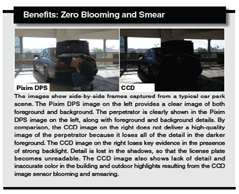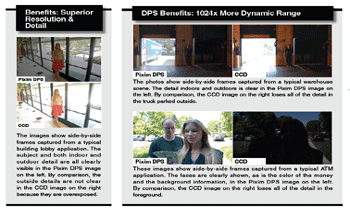Intelligent video surveillance analytics requires sharp images to run properly. Todd Rockoff, Vice President of Asia Sales at Pixim, discussed capturing clear images at the Global Digital Surveillance Forum, part of SecuTech Expo 2007, in Taipei, Taiwan.
New digital technologies greatly enhance the value of video surveillance. Even though video surveillance historically has been an analog mediu...
Intelligent video surveillance analytics requires sharp images to run properly. Todd Rockoff, Vice President of Asia Sales at Pixim, discussed capturing clear images at the Global Digital Surveillance Forum, part of SecuTech Expo 2007, in Taipei, Taiwan.
.gif)
New digital technologies greatly enhance the value of video surveillance. Even

though video surveillance historically has been an analog medium, today's analog transmission systems rely heavily on digital components to process and record video evidence. Surveillance practitioners increasingly take advantage of the Internet to allow flexible, remote monitoring of video surveillance. Moreover, system designers are adopting analytics capabilities, whereby computers monitor digital video to derive important statistics from scenes or to identify situations potentially requiring human intervention.
The technical requirements of digital video differ from those of analog video requiring system designers to adopt new ways of measuring the performance of image capture subsystems. The various candidate image capture technologies include CCDs, CMOS Active Pixel Sensors (APS) and Piximˇs Digital Pixel System (DPS) technology.
The Digital Surveillance Challenge
Internet video promises unprecedented flexibility and remote-control capabilities for surveillance systems. However, the promise of Internet surveillance is constrained by the precious network resources of storage and bandwidth.
Machine analysis of surveillance video could be the solution to unlocking the full value of digital surveillance and promises great economic advantages for security systems. If false negatives and false positives can be eliminated, analytics can remove human error and greatly leverage human resources available to secure a given facility.

Together, Internet video and analytics can extend the reach of a surveillance operation and greatly leverage the human resources available.
In order to unlock the full value of Internet video and analytics, digital surveillance requires high-quality video capture under diverse conditions. Some of the key performance characteristics are as follows:
Excellent low-light sensitivity
Accurate color reproduction
Operation across a broad temperature range
High resolution
Accuracy under bright lighting
Minimum analog conversion artifacts
DPS Technology
The core invention of DPS is the digital pixel. A derivative of technology licensed from Stanford University, the digital pixel is a sensor design wherein every pixel includes a dedicated Analog-to-Digital Converter (ADC).
When combined with high-speed memory on the sensor, the digital pixel enables wide dynamic range (17 bits = 128,000:1) and excellent low-light performance.
Wide Dynamic Range (WDR) is achieved through Piximˇs patented Mul t i -Sampl ing t e chnology. In Multi-Sampling, each pixel is measured 144 times per 1/60 second field exposure. Such a high sampling rate is a direct benefit of the digital pixel, which allows the full pixel array to be read in the same way as a high-speed memory. In each field exposure, the system retains the value at each pixel that gives the best Signal-to- Noise Ratio (SNR). Piximˇs proprietary rendering algorithms then combine the samples taken at various times during the field time to yield a best-looking result on a video display.
In effect, Multi-Sampling enables every pixel to determine its own shutter speed during each video field capture as a function of the light impacting that pixel in that frame.
DPS: Enabling Digital Surveillance
Higher-quality video provided as input to a video compression chip gives better compression results, which in turn means less storage and less bandwidth needed to convey video at a given quality level. Higher-quality video also gives more accurate analytics results. Piximˇs solution provides several advantages for digital video, including the following:
Native ITU656 output No board-level analog conversion Signals are all digital from pixel to packet
Native progressive scan Global electronic shuttering No motion tearing Higher compression rates than CCDs Higher analytics accuracy
Less readout noise than CCDs Higher compression rates than CCDs Higher analytics accuracy
Higher vertical resolution than CCDs Higher analytics accuracy
More natural colors than CCDs Higher analytics accuracy
Digital surveillance demands high-quality video capture under diverse conditions.
